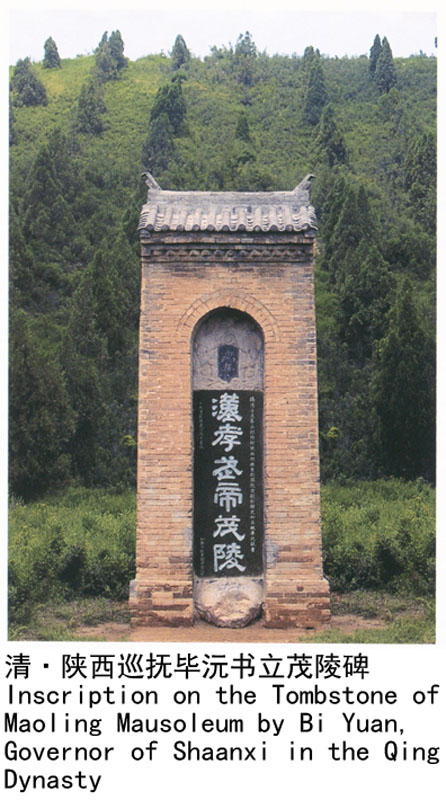第一章 三、茂陵陵园的特殊性
王志杰
汉初帝陵和皇后墓在同一墙垣之内,帝陵的寝殿、便殿等建筑,均在陵园墙垣之内。自文帝霸陵以后,陵园的形制发生了很大的变化,帝陵和皇后墓,不再在同一陵园之内,而各相距几里之遥;寝殿、便殿和陵庙的建置,不在陵园墙垣之内,而建筑在陵园墙垣之外。
西汉帝陵与皇后墓的位置,大都是“帝西后东”。它是仿照未央宫为皇帝宫,长乐宫为太后之宫。因未央宫居西,又称西宫;长乐宫居东,又称东宫。因此,帝陵陵园象征未央宫,皇后墓园象征长乐宫。
两汉诸帝陵,大都有皇亲、国戚、达官、显贵陪葬。陪葬墓一般都分布在陵区东部和北部,如阳陵、茂陵,有不少的陪葬墓都在陵区东部,这就犹似居东向西朝谒之仪。
茂陵陵园分内城和外城,内、外城四周都有城门,内城东、西、北三面门的遗址,至今依然可见。茂陵位于陵园正中。据《汉书·韦玄成传》和《长安志》卷14的记载,陵旁立庙,陵园有寝殿、便殿。“日祭于寝,月祭于庙,时祭于便殿。寝,日四上食;庙,岁二十五祠;便殿,岁四祠。又月一游衣冠。”主管官吏有陵令、属官各1人,寝、庙令各1人,园长1人,门吏33人,候4人,而守陵、灌树、扫除的杂工等多至5000人。
《中国帝王陵寝》载:陵园东南是汉武帝原庙,称“龙渊宫”。寝殿与原庙间有一条规整的通道,称“衣冠所出之道”。每当祭祀时,把武帝的衣冠由寝殿迎出,经此道送进庙中,接受百官谒拜,祭奠后又经此道将衣冠送回寝殿安放。
寝殿功能,文献记载:“古不墓祭,汉诸陵皆有园寝。”“园寝”是为“墓祭”而建筑的。园寝即陵园之寝殿。寝殿的形制,《尔雅·释宫》载:“室有东西厢曰庙,无东西厢有室曰寝。”
便殿与寝殿关系甚为密切,所谓“便殿者,寝侧之别殿耳”。便殿意义,“凡言便殿、便室者,皆非正大之处”。它的功能,据文献所载:“便殿为休息闲宴之处耳”。它又一作用,就是储藏器物及衣物。《后汉书·礼仪志》说:“容根车游载容衣,司徒至便殿,并轚(音铿)骑皆从容车至玉帐下,司徒跪曰:‘请就幄’,导定。尚衣奉衣,以次奉器、衣物,藏于便殿。”
在茂陵园区发现两处建筑遗址。一处是白鹤馆遗址:茂陵东南350米处,有白鹤馆遗址。白鹤馆是寝殿的附属建筑,以供墓主游乐。今遗存的白鹤馆址,是一个不规则的长方形土丘,东西长39.43米,南北宽29.43米,高3米,夯土基座。附近遍地有汉代砖瓦残块以及红烧土。
再一处是集仙台遗址:在茂陵西北角100米处,有一长方形建筑遗址,夯土基座,其周围有大量瓦砾,东西长53米,南北宽41米,高近5米。
据史籍载,在茂陵园的外城周围,还建有“驰逐走马馆”和“西园”,专为在阴界的汉武帝游乐之用。陵园之中,有供给数百乃至上千宫女陪伴刘郎的游乐场所。可惜这些地方的建筑至今已无痕迹。据史书记载,或人们推测,在茂陵园内城或外城,当有汉武帝在世时最喜好的狩猎场,吟诗作赋的柏梁台,以及三十六宫“土花碧”等遗迹,只是至今尚未发现。从上述所见,茂陵陵园与其他汉帝陵园相比,极富特殊性。
C Unique Characteristics of Maoling Mausoleum Area
The Maoling Mausoleum of Emperor Wudi and the tomb of the empress lay on the same side of the wall of the mausoleum area.Their sleeping quarters and the reception rooms were generally constructed at the mausoleum area.Emperor Liu Huan(Wendi,reigned 179-156 B.C.)broke the burial system of mausoleum distribution.He had his mausoleum constructed at the mausoleum area but the tomb of the empress built at otherwise location.
In the Western Han Dynasty(206 B.C.-25 A.D.),the mausoleums for emperors were generally located to the west and the tombs of their empresses to the east.The location originated from imitation of the Weiyang Palace(meaning life coming to no end),which,located west,was for use by emperors and imitation of the Changle Palace(meaning long life),which,located east,was for use by empresses.Therefore,mausoleums for emperors symbolized the Weiyang Palace and mausoleums for empresses symbolized the Changle Palace.
Most of the mausoleums in the Western Han Dynasty had satellite tombs where were buried their relatives of the family lineage and high-ranking nobles.The satellite tombs were distributed east and north to mausoleum areas.For example,the Yangling Mausoleum and the Maoling Mausoleum had many satellite tombs lying east to the mausoleum areas.According to the records in Sleeping Quarters of China Mausoleums,a ceremonial temple was built southeast to the Maoling Mausoleum.Every time when a sacrificial ceremony was held,the clothing and the hat worn by Emperor Wudi were taken out in humble reverence from the sleeping quarters into the temple,where the emperor incarnate received homage paid by officials.When the ceremony was over,the clothing and the hat were brought back along the same path to the sleeping quarters.
The sleeping quarters was where the soul of the deceased might rest in peace.
The reception room had close relationship with the sleeping quarters.The place,apart from the use for casual rest,was used to store ceremonial objects and clothing.
Two sites of architectural remains were discovered at the Maoling Mausoleum Area.One is the remains site of White Crane Pavilion lying 350m southeast to the Maoling Mausoleum.
The site is an irregularly oblong hill,whose foundation of rammed earth is measured by length of 39.43m east-west,width of 29.43m north-south and height of 3m,with quantities of broken tiles and bricks scattering about.The White Crane Pavilion,a site for enjoyment by the tomb occupant,was an attached architecture to the sleeping quarters.The other is the remains site of Tombs Group in oblong shape lying 100m northwest to the Maoling Mausoleum of Emperor Wudi,the Han Dynasty.The foundation of rammed earth is measured by length of 53m east-west,width of 41m north-south and height of 5m,with quantities of debris scattering about.
The Maoling Mausoleum Area was separated into exterior and interior,both of which had a gate facing east,west,south and north respectively.The remains of interior gates facing east,west and north are still visible.The Maoling Mausoleum lies at the center of the Mausoleum Area.


茂陵文物鉴赏图志/王志杰著.—西安:三秦出版社,2012.